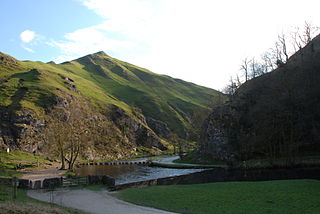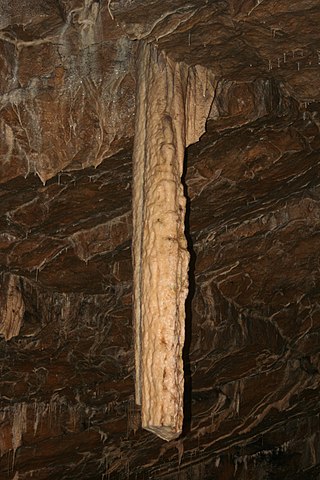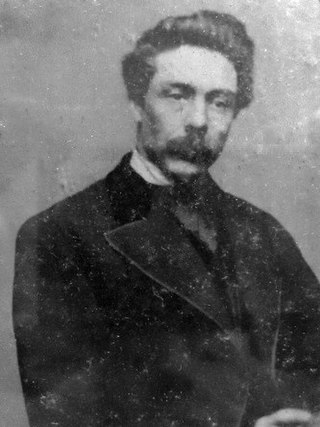
The Peak District is an upland area in England, at the southern end of the Pennines. Mostly in Derbyshire, it extends into Cheshire, Greater Manchester, Staffordshire, West Yorkshire and South Yorkshire. It is subdivided into the Dark Peak, moorland dominated by gritstone, and the White Peak, a limestone area with valleys and gorges. The Dark Peak forms an arc on the north, east and west of the district, and the White Peak covers central and southern areas. The highest point is Kinder Scout. Most of the area is within the Peak District National Park, a protected landscape designated in 1951.

Derbyshire is a ceremonial county in the East Midlands of England. It borders Greater Manchester, West Yorkshire, and South Yorkshire to the north, Nottinghamshire to the east, Leicestershire to the south-east, Staffordshire to the south and west, and Cheshire to the west. Derby is the largest settlement, and Matlock is the county town.

Buxton is a spa town in the Borough of High Peak, Derbyshire, in the East Midlands region of England. It is England's highest market town, sited at some 1,000 feet (300 m) above sea level. It lies close to Cheshire to the west and Staffordshire to the south, on the edge of the Peak District National Park. In 1974, the municipal borough merged with other nearby boroughs, including Glossop, to form the local government district and borough of High Peak.

The White Peak, also known as the Low Peak, is a limestone plateau that forms the central and southern part of the Peak District in England. It is mostly between 270 metres (900 ft) and 430 metres (1,400 ft) above sea-level and is enclosed by the higher altitude Dark Peak to the west, north and east.

Sir William Boyd Dawkins was a British geologist and archaeologist. He was a member of the Geological Survey of Great Britain, Curator of the Manchester Museum and Professor of Geology at Owens College, Manchester. He is noted for his research on fossils and the antiquity of man. He was involved in many projects including a tunnel under the Humber, a Channel Tunnel attempt and the proving of coal under Kent.

Dovedale is a valley in the Peak District of England. The land is owned by the National Trust and attracts a million visitors annually. The valley was cut by the River Dove and runs for just over 3 miles (5 km) between Milldale in the north and a wooded ravine, near Thorpe Cloud and Bunster Hill, in the south. In the wooded ravine, a set of stepping stones cross the river and there are two caves known as the Dove Holes.

The history of Derbyshire can be traced back to human settlement since the last Ice Age, over 10,000 years ago. The county of Derbyshire in England dates back to the 11th century.

Trevor David Ford was an English geologist and author, best known for publishing the first report on the Precambrian fossil Charnia masoni in 1958. In addition to paleontology, his wide-ranging research encompassed geomorphology, speleology, studies of minerals and mineralisation, and mining history, and mainly focused on the Peak District. His academic career was at the Department of Geology of the University of Leicester, where he rose to be a senior lecturer (1980–87) and associate dean for combined studies in science. He was the founding editor of the journal now entitled Cave and Karst Science (1973–93), and published many books, both academic texts and books aimed at a broader audience, including cave guides, and guides to geology and minerals.

Poole's Cavern or Poole's Hole is a two-million-year-old natural limestone cave on the edge of Buxton in the Peak District, in the county of Derbyshire, England.

Eldon Hill is a hill in the Peak District National Park in the county of Derbyshire, England, 4 kilometres (2.5 mi) southwest of the village of Castleton. It is a 470-metre (1,540 ft) limestone hill whose pastureland is used for rough grazing, although a large proportion has been lost to limestone quarrying. It lies within the Castleton Site of Special Scientific Interest. Eldon Hill was formed when a bed of pure limestone was squeezed and upfolded by geological forces to form a dome; it is the highest limestone hill north of the River Wye.

King Sterndale is a village and civil parish in Derbyshire, England. It is located in the Peak District, 4 miles east of Buxton. It has a population of about 30, increasing to 133 at the 2011 Census. The two hamlets of Cowdale and Staden also lie within the parish.

White Watson was an early English geologist, sculptor, stonemason and carver, marble-worker and mineral dealer. In common with many learned people of his time, he was skilled in a number of artistic and scientific areas, becoming a writer, poet, journalist, teacher, botanist and gardener as well as a geologist and mineralogist. He kept extensive diaries and sketchbooks of his observations on geology, fossils and minerals, flora and fauna, and published a small but significant and influential number of geological papers and catalogues. As an artist he was well known locally for his silhouettes, both on paper and as marble inlays.
William Martin was an English naturalist and palaeontologist who proposed that science should use fossils as evidence to support the study of natural history. Martin published the first colour pictures of fossils and the first scientific study of fossils in English.

Ashford Black Marble is the name given to a dark limestone, quarried from mines near Ashford-in-the-Water, in Derbyshire, England. Once cut, turned and polished, its shiny black surface is highly decorative. Ashford Black Marble is a very fine-grained sedimentary rock, and is not a true marble in the geological sense. It can be cut and inlaid with other decorative stones and minerals, using a technique known as pietra dura.
John Wilfrid Jackson was a British conchologist, archaeologist and geologist.

Deep Dale is a short steep-sided gorge near Buxton, Derbyshire, in the Peak District of England. It is distinct from another Deep Dale, near Sheldon, 4 miles (6.4 km) to the east.

The Derbyshire Dome is a geological formation across mid-Derbyshire in England.

The Wye Valley is the limestone valley of the River Wye in the White Peak of Derbyshire, England. The source of the River Wye is west of Buxton on Axe Edge Moor. One main channel runs underground through Poole's Cavern. The river flows though Buxton Pavilion Gardens and then along a culvert under the town centre. After leaving the flat area of central Buxton, the Wye Valley becomes distinct as a gorge running east for 10 miles (16 km) before the valley broadens at Ashford-in-the Water.

The Seven Wonders of the Peak were described in the 17th century by the philosopher Thomas Hobbes in his book De Mirabilibus Pecci: Being The Wonders of the Peak in Darby-shire, Commonly called The Devil's Arse of Peak. The wonders refer to places to visit in the Peak District of Derbyshire in England.

Micah Salt was a tailor and amateur archaeologist from Buxton in Derbyshire.




















